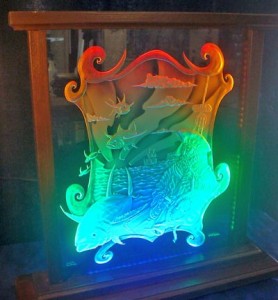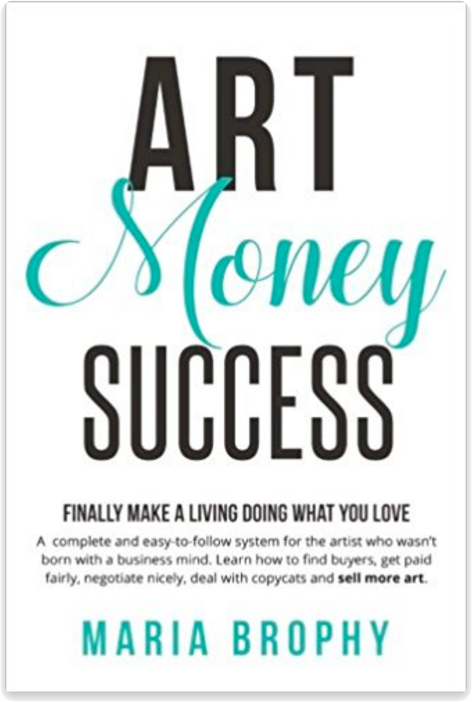
How do you determine the difference between inspiration and plagiarism? It’s easy, but don’t ask me to explain it. Just like Supreme Court Justice Potter Stewart once said of Pornography, “I don’t know how to define it, but I know it when I see it.”
One of the oldest sins in art is knocking off someone else’s creation and selling it.
Artwork is as personal as your children. It comes out of us, and we not only get possessive of it, we have a deep drive to protect its purity.
If you want to get an artist really angry, just show them where their art’s been copied and sold without their knowledge. Selling one’s work as your own, without permission, is a hot button that brings out the ugly in people.
A good example is the never-ending debate surrounding Shepard Fairey, the famed artist of the Obama HOPE poster. Although accomplished and talented, he’s probably spent a lot of time and money defending his choice to use the copyright image of photographer Manny Garcia without permission. His fans will tell you that it was “fair use” or “appropriation,” terms that get him off the hook legally. His critics will argue that he plagiarized the image for his own personal gain.
Regardless of how the law handles copyright infringement, no one is happy to discover that someone has taken their artwork without their knowledge.
WHY COPY SOMEONE’S WORK?
There are many reasons one would. Companies will do it out of ignorance or greed. For newly born artists, it may be what helps them to find their footing. For some, it’s an attempt to create something which they are incapable of doing on their own.
It’s frustrating for artists who constantly get knocked off by others who are selling their stolen art. Lowbrow artist David Lozeau has his art plagiarized so often that he instituted a program where he gives free prints to whistle blowers that alert him to it! He then goes after the infringer and puts a stop to it. He has an entire Flicker stream of his stolen art. You can understand why people would want to steal his images – his artwork is unique and very desirable. The problem is that the people copying his art are doing it for their own financial gain without his permission.
WHEN IT’S OKAY TO COPY SOMEONE’S WORK:
I wrote an article titled Is your art an Influence or a Knock Off about the virtues of being influenced by an artist before you, and how beautiful it is to pass that influence onto the next generation. So you might think that I’m contradicting myself with this article.
Let me be clear: There is a distinct difference between having your art and style influenced by another’s work and downright copying another’s work and selling it, without permission.

TO HELP YOU LEARN: If you are learning to paint, imitating the paintings of your favorite artist can help you to develop better techniques and to gain inspiration. If you don’t plan on selling these paintings, there’s no ethical issue by doing this.
FOR PUBLIC WORKS: Community beautification projects can benefit from the works of an established artist. Recently we were contacted by a public school asking permission to copy one of Drew’s underwater paintings on the side of a building. We happily gave permission.
COLLABORATION OR PARTNERSHIP: Partnering to collaborate on a unique piece of art is exciting. In this case, you have the full participation of the artist that you are working with. An example is of glass artist Kyle Hunter Goodwin. He is extremely talented and is constantly challenging himself with new projects. He asked if he could take Drew’s pirate painting and create a large, glass carving of the image. He offered a percentage of the sale. The result is a great piece of artwork and everyone benefits from the partnership.
WHEN YOU GET PERMISSION: If you plan to sell the art that you’re copying or deriving from, always ask permission and give the artist written credit. Offering to pay them a percentage of your earnings is recommended. That way they are getting something out of it, too, and it’s a win-win for everyone.
WHEN IT’S NOT OKAY TO KNOCK OFF SOMEONE’S WORK:
There can be serious problems with copying someone else, without permission, and passing it off as your own. They are:
CONFUSION: You are causing confusion with the public. People will see your art and confuse it with the other person’s. This does not help either one of you.
DIMINISHES YOUR RESPECT AS AN ARTIST: People may not respect you as an artist. They may claim that you can’t do it on your own, that you have to steal from someone else. This does not contribute to your success.
STUNTS YOUR GROWTH AS AN ARTIST: You will never grow as an artist if you are outright reproducing someone’s art and style. To grow, you must challenge yourself and cultivate your own look.
ILLEGAL: If you are knocking off another’s work for financial gain, you are violating copyright laws. You could be sued and/or get very bad publicity from it.
YOU’LL GET SHUT DOWN: When you have an account on Esty.com, Zazzle.com or similar sites, you’ll have your account shut down if they get complaints about you selling copied images. David Lozeau has shut down a few sellers on Etsy.com that have stolen his artwork.
WHAT TO DO WHEN YOU ARE ASKED BY A CLIENT TO COPY SOMEONE’S WORK:
It’s an insult to say to an artist “Hey, I like your work, but will you copy this other guy’s art for me?” It can also be illegal. But some people aren’t aware of the ethics of it all. As an artist, it’s up to you to educate your clients on this.
Occasionally we’ll have a client ask Drew to paint someone else’s art for them. “Here’s a copy of what I want painted on my surfboard.” They hand us a printout of someone’s artwork. When this happens, Drew will let them know that he will be happy to paint the subject or theme in his own way, in his own style.
When someone asks you to copy another’s artwork, tell them no and then give a suggestion as to what you will paint instead, in your own style and of your own design. Let them know that you don’t want to break any copyright laws. Once you point that out, people understand.
WHAT TO DO WHEN YOU’RE WORK IS BEING COPIED: You’ve worked hard developing your own style and creating a name for yourself in the art world. You’ve put in the 10,000 hours it takes to find success, and you are reaping the benefits.
But there’s a problem that comes with the success. Others, artists or companies, are copying your work. You find out from other people. A friend e-mails saying “I saw another one of your knock offs today.” It’s frustrating to see that someone else is riding the coat tails of your success. And they aren’t even thanking you for it!
They say that imitation is a form of flattery. When people copy you, it means that you are impacting people with your art. If your art wasn’t striking a chord with people, no one would pay attention or want to emulate you.
But on the other hand, it’s confusing others. Some people are mistaking the unrefined work of that emerging artist with yours. And you don’t want that.
 Every time we walk a surf industry trade show, we find Drew Brophy knock-offs. This past February at ASR in San Diego we found his “Joe Tiki” drawing on skim boards. I didn’t let the infringer know who I was until after I took his photo (see photo to the left) then I announced that he was breaking copyright laws. I followed up with a Cease & Desist and he apologized. Apparently, one of his customers gave him the artwork without saying that it was stolen art. It ended nicely.
Every time we walk a surf industry trade show, we find Drew Brophy knock-offs. This past February at ASR in San Diego we found his “Joe Tiki” drawing on skim boards. I didn’t let the infringer know who I was until after I took his photo (see photo to the left) then I announced that he was breaking copyright laws. I followed up with a Cease & Desist and he apologized. Apparently, one of his customers gave him the artwork without saying that it was stolen art. It ended nicely.
You can stop it by sending a Cease and Desist letter. I’ve put a sample letter at the bottom of this post.
If that doesn’t work, you could hire an attorney. The bummer is that attorneys cost a lot of money, sometimes more than you’ll get if you sue. I would take that route only against a large company that is selling large quantities of your knock-offs. As a last resort, you could always hire your cousin Vinny to take ‘em out at the knees! (It may cost less than an attorney, and be more effective.)
For more suggestions, read What to Do When Someone Steals Your Content.
IF YOU MUST KNOCK OFF SOMEONE ELSE:
Nine years ago I was abroad and met a surfer who was painting surfboards at a surf camp I was staying in. We were talking and he sort of apologized and said “Drew has been a big inspiration to me. I have to admit, a lot of my clients ask me to copy his art. But when I do, I always write on it that it was a copy of Drew Brophy’s.”
So let’s say you copy the artwork of a living artist today. You do it because you want to learn more about painting, and it’s for your own collection. Or you copy someone’s art for a paying client.
So that you can live with yourself and save some embarrassment, and maybe even a lawsuit, here’s what you do:
1.) Sign the artwork with a statement that says “Copy of (Artists name here) design by (your name here)”.
2.) If it’s for sale: Get permission.
3.) Be careful of what your client’s ask you to paint: If a client hands you a picture of something that they want you to produce, confirm that it’s their own design. If not, require that they get the written permission of the artist who first created it. Keep this written permission in your records to protect yourself.
4.) Offer to pay the artist a percentage of your earnings.
I have a few caveats to this idea of not allowing for duplication of your artwork. You’ll notice that throughout this post I refer to artwork taken without permission for financial gain. This is where I have the problem with people duplicating art.
When it comes to sharing your art, I have a completely different viewpoint. I love the idea of spreading art around the world, allowing others to use it freely for their blogs, magazine articles and printing it out and taping it to their wall. It’s a true benefit when a writer takes an image of yours and posts it on their blog, with links to your site. I see that act as a win-win for all.
When in doubt, use the Golden Rule. It says do unto others as you would have them do unto you.
Please, share your comments in the section below. I’d love to hear your experiences with this.
Respectfully Yours, Maria xxoo
SAMPLE CEASE & DESIST LETTER:
I’ve paraphrased a sample letter from the HANDBOOK: PRICING & ETHICAL GUIDELINES, 12TH EDITION and combined it with my own attorney’s much shorter Cease & Desist letter. You can use this as a template and make changes to it as needed.
Dear (Insert infringing Artist or companies name here):
I’ve become aware that you have made an unauthorized use of my copyrighted Work (herein referred to as Work) entitled ________. Please be aware that I have reserved all rights in the Work, which was first published _____________. (If you have filed a copyright, include “I have registered copyright for the Work on _______________”).
Your work entitled ____________ is essentially identical to my copyrighted Work.
As you neither asked for nor received permission to use the Work, I believe you have willfully infringed my rights under 17 U.S.C. Section 101 et seq. and could be liable for statutory damages as high as $150,000 as set forth in Section 504(C) (2) therein.
I demand that you immediately cease the use and distribution of all infringing works derived from the Work, and all copies, including electronic copies, of the same, and that you deliver to me all unused, undistributed copies or destroy such copies immediately and that you desist from this or any other infringement of my rights in the future.
If I have not received an affirmative response from you within 15 business days of the date of this notice, indicating that you have fully complied with these requirements, I shall take further action against you.
Sincerely,
_______________________
.














